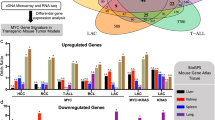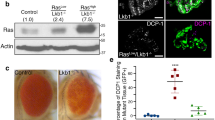Abstract
Previous studies have indicated an important role for the Raf family of protein kinases in controlling cellular responses to extracellular stimuli and activated oncogenes, through their ability to activate the MEK/ERKs. To investigate the specific role of A-Raf in this process we generated A-Raf deficient mouse embryonic fibroblasts (MEFs) and embryonic stem (ES) cells by gene targeting and characterized their ability to undergo proliferation, differentiation, apoptosis, ERK activation, and transformation by oncogenic Ras and Src. The A-Raf deficient cells are not disrupted for any of these processes, despite the fact that this protein is normally expressed at high levels in both cell types. This implies either that A-Raf plays no role in MEK/ERK activation, that its function is fully compensated by other Raf proteins or MEK kinases or that its role in MEK/ERK activation is highly tissue-specific. Interestingly, B-Raf and Raf-1 activity towards MEK as measured by the immunoprecipitation kinase cascade assay are both significantly increased in the A-Raf deficient MEFs.
This is a preview of subscription content, access via your institution
Access options
Subscribe to this journal
Receive 50 print issues and online access
$259.00 per year
only $5.18 per issue
Buy this article
- Purchase on Springer Link
- Instant access to full article PDF
Prices may be subject to local taxes which are calculated during checkout





Similar content being viewed by others
References
Barnier JV, Papin C, Eychene A, Lecoq O, Calothy G . 1995 J. Biol. Chem. 270: 23381–23389
Bogoyevitch MA, Marshall CJ, Sugden PH . 1995 J. Biol. Chem. 270: 26303–26310
Daum G, Eisenmann-Tappe I, Fries HW, Troppmair J, Rapp UR . 1994 Trends Biochem. Sci. 19: 474–480
Gubbay J, Vivian N, Economou A, Jackson D, Goodfellow P, Lovell-Badge R . 1992 Proc. Natl. Acad. Sci. USA 89: 7953–7957
Hagemann C, Kalmes A, Wixler L, Schuster T, Rapp UR . 1997 FEBS Let. 403: 200–202
Hagemann C, Rapp UR . 1999 Exp. Cell Res. 253: 34–46
Huleihel M, Goldsborough M, Cleveland J, Gunnell M, Bonner T, Rapp UR . 1986 Mol. Cell. Biol. 6: 2655–2662
Hüser H, Luckett J, Chiloeches A, Mercer K, Iwobi M, Giblett S, Sun X-M, Brown J, Marais R, Pritchard C . 2001 EMBO J. 20: 1940–1951
Kolch W, Heidecker G, Lloyd P, Rapp UR . 1991 Nature 349: 426–428
Luckett JCA, Huser MB, Giagtzoglou N, Brown JE, Pritchard CA . 2000 Cell Growth Differ. 11: 163–171
Marais R, Light Y, Paterson HF, Mason CS, Marshall CJ . 1997 J. Biol. Chem. 272: 4378–4383
Mason CS, Springer CJ, Cooper RG, Superti-Furga G, Marshall CJ, Marais R . 1999 EMBO J. 18: 2137–2148
Mikula M, Schreiber M, Husak Z, Kucerova L, Ruth J, Wieser R, Zatloukal K, Beug H, Wagner EF, Baccarini M . 2001 EMBO J. 20: 1952–1962
Pritchard CA, Samuels ML, Bosch E, McMahon M . 1995 Mol. Cell. Biol. 15: 6430–6442
Pritchard CA, Bolin L, Slattery R, Murray R, McMahon M . 1996 Curr. Biol. 6: 614–617
Qureshi SA, Joseph CK, Hendrickson M, Song J, Gupta R, Bruder J, Rapp U, Foster DA . 1993 Biochem. Biophys. Res. Comm. 30: 969–975
Samuels ML, Weber MJ, Bishop JM, McMahon M . 1993 Mol. Cell. Biol. 13: 6241–6252
Sladek TL, Jacobberger JW . 1992 Oncogene 7: 1305–1313
Storm SM, Cleveland JL, Rapp UR . 1990 Oncogene 5: 345–351
Treinies I, Paterson HF, Hooper S, Wilson R, Marshall CJ . 1999 Mol. Cell. Biol. 19: 321–329
Wojnowski L, Stancato LF, Larner A, Rapp UR, Zimmer A . 2000 Mech. Devel. 91: 97–104
Woods D, Parry D, Cherwinsky H, Bosch E, Lees E, McMahon M . 1997 Mol. Cell. Biol. 17: 5598–5611
Yuryev A, Ono M, Goff SA, Macaluso F, Wennogle LP . 2000 Mol. Cell. Biol. 20: 4870–4878
Acknowledgements
We thank Susan Giblett for embedding and sectioning the teratomas, Mabel Iwobi for the PCR data, Martin McMahon for providing the pZAS4ras and pZAS4src vectors and Lee Topping for help with statistics. We are also grateful to the Division of Biomedical Services at Leicester for their technical assistance. This work was supported by a BBSRC studentship to K Mercer, a Royal Society fellowship to C Pritchard, and project grants from the Medical Research Council and the Cancer Research Campaign. We thank these organisations for their invaluable support.
Author information
Authors and Affiliations
Corresponding author
Rights and permissions
About this article
Cite this article
Mercer, K., Chiloeches, A., Hüser, M. et al. ERK signalling and oncogene transformation are not impaired in cells lacking A-Raf. Oncogene 21, 347–355 (2002). https://doi.org/10.1038/sj.onc.1205101
Received:
Revised:
Accepted:
Published:
Issue Date:
DOI: https://doi.org/10.1038/sj.onc.1205101
Keywords
This article is cited by
-
Potential role of AKT/mTOR signalling proteins in hairy cell leukaemia: association with BRAF/ERK activation and clinical outcome
Scientific Reports (2016)
-
ERK/pERK expression and B-raf mutations in colon adenocarcinomas: correlation with clinicopathological characteristics
World Journal of Surgical Oncology (2012)
-
Role of Ras/Raf/MEK/ERK signaling in physiological hematopoiesis and leukemia development
Immunologic Research (2011)
-
Expression of pERK and pAKT in human astrocytomas: correlation with IDH1-R132H presence, vascular endothelial growth factor, microvascular characteristics and clinical outcome
Virchows Archiv (2011)
-
Raf kinase signaling functions in sensory neuron differentiation and axon growth in vivo
Nature Neuroscience (2007)



